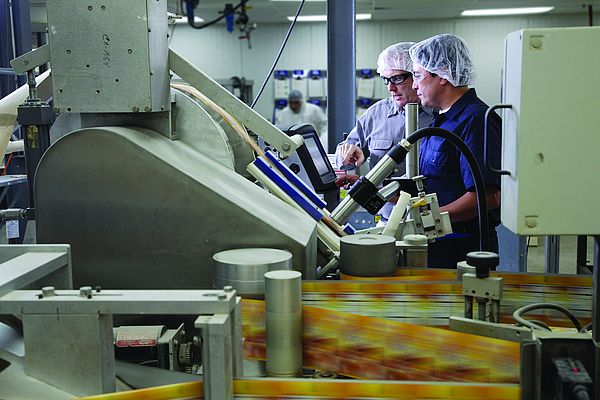Product coding during the packaging process is a vital part of fast-moving consumer goods (FMCG) manufacturing, improving supply chain efficiency and visibility, while also providing consumers with important product information and prominently displaying brand identity. In the low-margin, high-volume world of FMCG manufacturing, the cost of coding errors can spread rapidly across the supply chain from the manufacturing facility to the store shelves.
Coding errors necessitate costly re-work and material waste when re-work is not possible and labels or, in primary packaging instances, the entire product must be scrapped. The reallocation of valuable time and resources directly affects the ability of a 24/7 manufacturing facility to run effectively, reducing throughput and profits. Miscoded products on store shelves result in consumers receiving inaccurate information about the products they have purchased which not only alienates the customer, but can result in severe regulatory penalties and fines as well as costly product recalls. In some high-profile cases, ensuing media coverage can cause irreparable damage to brand reputation, negatively impacting sales.
In order to effectively "repair" the coding process, we must first identify the root cause. According to a Videojet survey with variety of FMCG manufacturers, up to 70 percent of coding errors are caused by operator error, with approximately half of these caused by mistakes in code entry and job selection. In addition, it was discovered that coding errors are not the deviation, but the norm. Nearly half of FMCG manufacturers participating in the survey revealed that coding errors occur at least weekly, while 25 percent of respondents reported them as a daily occurrence. The unfortunate fact is that coding errors have become commonplace, but they do not have to be.
While FMCG manufacturers would typically put additional checks in place during packaging to address coding errors, this does not necessarily handle the issue effectively or efficiently. By working with an experienced printing partner with extensive printer capabilities and system design know-how, FMCG manufacturers can create and implement a coding process with built-in code assurance elements that limit the potential for user error. Simplifying the process of message selection and entry through the use of automation and software tools can greatly prevent coding errors, increasing productivity, reducing waste, and minimizing operational costs and risk management.
Automated code assurance
"Poka-yoke" is a Japanese term that can be translated as "mistake-proofing". When applied to manufacturing operations, a poka-yoke is any measure put into place during the manufacturing process designed to prevent human errors before they occur. The right printing partner can help an FMCG manufacturer to design a comprehensive system that implements various poka-yoke principles through advances in printing technology, eliminating coding and marking errors.
Intelligent user interface
Using an operator interface designed with existing code assurance tools can simplify message selection, restrict operator input and automate messages. For example, the printer's user interface can include features such as separate user authorization for code creation and job selection, restricted and pre-approved coding parameters, and job storage under intuitive names that speak directly to the product being coded. In addition, the user-friendly interface allows calendar selection for dates to eliminate erroneous formats due to regional or product differences, and link product dates that automatically use the "Sell By" date to determine the "Use By" date. Other simplified options can include, setting calendar rules to prevent the selection of certain dates like weekends or holidays, data selection drop down menus that eliminate incorrect key presses, confirmation of data to allow a print job to proceed, and confirmation of data prior to every job change to ensure the correct job has been selected. These design options should be an integral part of new generation thermal transfer printers, as well as ink jet coders, large character marking, laser or labelling printers, and thermal ink jet product lines.
Software and network message control
Implementing windows-based software can provide additional support, isolating code design from the production floor and eliminating the need to load individual message onto each printer interface. This PC-based message creation and management tool serves to remove human error from the coding equation.
In addition, network controls can further reduce operator input, pulling from authoritative data sources, making sure the right codes go to the right printers. These network-based coding messages can be distributed to multiple coding and labeling devices across a facility, or even several facilities. Using automated systems to simplify message creation and management greatly reduces the potential for human error and eliminates the need to message selection.
As part of a broader quality assurance system, these controls should be synched with existing Supervisory Control and Data Acquisition (SCADA), factory networks, Manufacturing Execution System (MES) and Enterprise Resource Planning (ERP) systems. Open data base connectivity (ODBC) allows coding messages to be created and stored in SQL, Access, Excel and generic databases. This comprehensive connectivity will allow job information access from any enabled coding or labeling system, ensuring efficiency, as well as protection against operator error.
Regulatory concerns
In addition to the costs associated with re-work and scrapped printing jobs, if products with coding inaccuracies reach store shelves this can result in fines and penalties, particularly when dealing with food and beverage products. In the United States, consumer packaged goods manufacturers are legally required to correctly display product information, such as ingredient or nutritional data mandated by the Nutrition Labeling and Education Act and the Federal Food, Drug and Cosmetic Act. In the European Union, Directive 2000/13/EC has been enacted to ensure that consumers have access to accurate information regarding the contents and composition of food and beverage products. Failure to comply with these standards can bring fines and even product recall - both costly and extremely damaging to any brand. A knowledgeable printing supplier can help FCMG manufacturers develop a streamlined labeling process that will meet global regulatory standards and avoid any potential issues due to coding errors.
According to a Videojet survey, coding errors on product packaging take place on a regular basis, resulting in lost time, resources and, brand integrity. With strict global labeling regulations for food products, coding errors can even result in fines and penalties, including product recall. While some might consider this the cost of doing business, it no longer has to be. The primary cause of most coding mishaps is human error. By working with an experienced printing partner to design a coding process with built-in code assurance elements (also known as poka-yoke principles), FCMG manufacturers can eliminate errors before the label is even applied to the product. Utilizing the latest in manufacturing automation, thermal printing, and software tools to simplify the process of message selection and entry can prevent coding errors, increasing productivity, reducing waste, minimizing operational costs, and increasing the bottom line.


















